| Listing 1 - 10 of 22 | << page >> |
Sort by
|
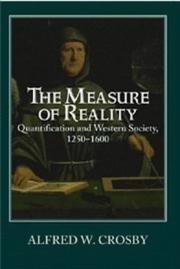
ISBN: 0521554276 0521639905 1139886665 1107702291 1107703514 1107597838 1107050510 1107701511 1107687292 9781461951780 146195178X 9781107050518 9780521554275 9781107702295 9781139886666 9781107701519 9781107687295 9781107597839 9781107703513 Year: 1997 Publisher: Cambridge : Cambridge University Press,
Abstract | Keywords | Export | Availability | Bookmark
 Loading...
Loading...Choose an application
- Reference Manager
- EndNote
- RefWorks (Direct export to RefWorks)
Western Europeans were among the first, if not the first, to invent mechanical clocks, geometrically precise maps, double-entry bookkeeping, precise algebraic and musical notations, and perspective painting. By the sixteenth century more people were thinking quantitatively in western Europe than in any other part of the world. The Measure of Reality, first published in 1997, discusses the epochal shift from qualitative to quantitative perception in Western Europe during the late Middle Ages and Renaissance. This shift made modern science, technology, business practice and bureaucracy possible.
History of civilization --- anno 1200-1499 --- anno 1500-1599 --- Western Europe --- Measurement --- Science --- Civilization, Medieval. --- Renaissance. --- Mesure --- Sciences --- Civilisation médiévale --- Renaissance --- History --- Histoire --- Historiometry. --- Methodology. --- Civilisation médiévale --- Arts and Humanities --- Revival of letters --- Civilization --- History, Modern --- Civilization, Medieval --- Civilization, Modern --- Humanism --- Middle Ages --- Medieval civilization --- Chivalry --- Historiography --- Historiometrics --- Biography --- Psychohistory --- Methodology --- Psychological aspects --- Mathematical models --- Statistical methods --- Europe --- 316.77 --- 930.86 --- 316.77 Communicatiesociologie --- Communicatiesociologie --- 930.86 Mentaliteitsgeschiedenis --- Mentaliteitsgeschiedenis
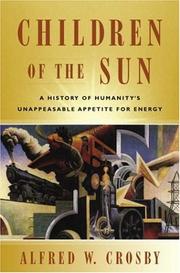
ISBN: 0393059359 Year: 2006 Publisher: New York, N.Y. Norton
Abstract | Keywords | Export | Availability | Bookmark
 Loading...
Loading...Choose an application
- Reference Manager
- EndNote
- RefWorks (Direct export to RefWorks)
History --- Relation between energy and economics --- Power resources --- Power resources. --- Solar energy --- History.
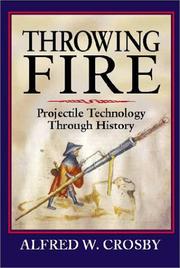
ISBN: 0521791588 Year: 2002 Publisher: Cambridge Cambridge University Press
Abstract | Keywords | Export | Availability | Bookmark
 Loading...
Loading...Choose an application
- Reference Manager
- EndNote
- RefWorks (Direct export to RefWorks)
Military engineering --- Projectiles --- -Shells (Projectiles) --- Shooting, Military --- Ballistics --- History --- -History --- Shells (Projectiles) --- History. --- Histoire.
Book
ISBN: 0837183766 Year: 1976 Publisher: Westport (Conn.): Greenwood
Abstract | Keywords | Export | Availability | Bookmark
 Loading...
Loading...Choose an application
- Reference Manager
- EndNote
- RefWorks (Direct export to RefWorks)
Influenza --- -Flu --- Flu, Respiratory --- Grippe --- Respiratory flu --- Respiratory infections --- Virus diseases --- History --- History. --- -History --- Flu

ISBN: 0521546184 1139883208 1107385962 110738396X 1107390397 1107398800 1107387477 0511805551 9781461941491 1461941490 9780511805554 9781107387478 0521837324 9780521837323 9780521546188 9781139883207 9781107385962 9781107390393 9781107398801 Year: 2004 Publisher: Cambridge : Cambridge University Press,
Abstract | Keywords | Export | Availability | Bookmark
 Loading...
Loading...Choose an application
- Reference Manager
- EndNote
- RefWorks (Direct export to RefWorks)
People of European descent form the bulk of the population in most of the temperate zones of the world - North America, Australia and New Zealand. The military successes of European imperialism are easy to explain; in many cases they were a matter of firearms against spears. But, as Alfred Crosby maintains in this highly original and fascinating book, the Europeans' displacement and replacement of the native peoples in the temperate zones was more a matter of biology than of military conquest. European organisms had certain decisive advantages over their New World and Australian counterparts. The spread of European disease, flora, and fauna went hand in hand with the growth of populations. Consequently, these imperialists became proprietors of the world's most important agricultural lands. Now in a second edition with a new preface, Crosby revisits his now-classic work and again evaluates the global historical importance of European ecological expansion.
Biogeography. --- Europeans --- Human ecology. --- Human geography. --- Migrations. --- Biogeography --- Human ecology --- Human geography --- Areography (Biology) --- Geographical distribution of animals and plants --- Species --- Species distribution --- Biology --- Geography --- Anthropo-geography --- Anthropogeography --- Geographical distribution of humans --- Social geography --- Anthropology --- Ecology --- Environment, Human --- Human beings --- Human environment --- Ecological engineering --- Nature --- Migrations --- Geographical distribution --- Social aspects --- Effect of environment on --- Effect of human beings on --- Arts and Humanities --- History
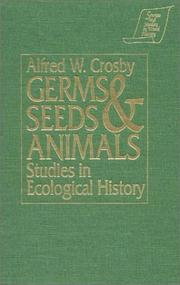
ISBN: 1563242508 Year: 1994 Publisher: Armonk M.E. Sharpe
Abstract | Keywords | Export | Availability | Bookmark
 Loading...
Loading...Choose an application
- Reference Manager
- EndNote
- RefWorks (Direct export to RefWorks)
HIS History & Biographies --- environmental history --- historical ecology --- eco history --- human ecology --- epidemics --- Europe --- migrations --- imperialism --- human geography --- biogeography
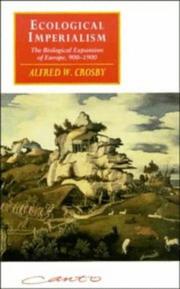
ISBN: 0521456908 9780521456906 Year: 1994 Volume: *5 Publisher: Cambridge: Cambridge university press,
Abstract | Keywords | Export | Availability | Bookmark
 Loading...
Loading...Choose an application
- Reference Manager
- EndNote
- RefWorks (Direct export to RefWorks)
Aardrijkskundige verspreiding van planten en dieren --- Anthropo-geography --- Anthropogeography --- Anthropogéographie --- Areography (Biology) --- Biogeografie --- Biogeography --- Biogéographie --- Biogéographie humaine --- Cultural geography --- Distribution géographique de l'homme --- Distribution géographique des plantes et des animaux --- Ecologie [Menselijke ] --- Ecologie humaine --- Ecology [Human ] --- Ecology--Social aspects --- Environment [Human ] --- Espace géographique --- Geografie [Bio] --- Geografie [Menselijke ] --- Geografische verspreiding van planten en dieren --- Geographical distribution of animals and plants --- Geographical distribution of man --- Geography [Cultural ] --- Geography [Human ] --- Geography [Social ] --- Géographie [Bio] --- Géographie humaine --- Homme -- Distribution géographique --- Human ecology --- Human environment --- Human geography --- Menselijke ecologie --- Menselijke geografie --- Oecoumène --- Oekoumène --- Social geography --- Écoumène --- Ékoumène --- Europeans --- Migrations --- Europeans - Migrations.
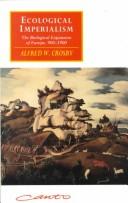
ISBN: 0521320097 0521336139 Year: 1992 Publisher: Cambridge : Cambridge university press,
Abstract | Keywords | Export | Availability | Bookmark
 Loading...
Loading...Choose an application
- Reference Manager
- EndNote
- RefWorks (Direct export to RefWorks)
Biogeography --- Europeans --- Human ecology --- Human geography --- Biogéographie --- Ecologie humaine --- Géographie humaine --- Migrations --- Biogeography. --- Human ecology. --- Human geography. --- Migrations. --- History of Europe --- Political philosophy. Social philosophy --- General ecology and biosociology --- anno 1200-1799 --- Politieke filosofie. Sociale filosofie --- Biogeografie --- Algemene ecologie en biosociologie --- Geschiedenis van Europa --- Anthropo-geography --- Anthropogeography --- Geographical distribution of humans --- Social geography --- Anthropology --- Geography --- Ecology --- Environment, Human --- Human beings --- Human environment --- Ecological engineering --- Nature --- Areography (Biology) --- Geographical distribution of animals and plants --- Species --- Species distribution --- Biology --- Social aspects --- Effect of environment on --- Effect of human beings on --- Geographical distribution
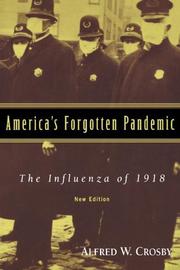
ISBN: 0521833949 0521541751 1107385938 0511586574 9780521541756 9780521833943 9780511586576 0511466110 0521385474 Year: 2003 Publisher: Cambridge: Cambridge university press,
Abstract | Keywords | Export | Availability | Bookmark
 Loading...
Loading...Choose an application
- Reference Manager
- EndNote
- RefWorks (Direct export to RefWorks)
Between August 1918 and March 1919 the Spanish influenza spread worldwide, claiming at least 30 million lives, more people than perished in the fighting of the First World War. It proved fatal to at least a half-million Americans. Yet, the Spanish flu pandemic is largely forgotten today. In this vivid narrative, Alfred W. Crosby recounts the course of the pandemic during the panic-stricken months of 1918 and 1919, measures its impact on American society, and probes the curious loss of national memory of this cataclysmic event." "In this new edition, with a new preface discussing the recent outbreaks of diseases, including the Asian flu and SARS, America's Forgotten Pandemic remains both prescient and relevant.--Publisher description.
Influenza --- Epidemics --- Influenza, Human --- Disease Outbreaks --- History --- history --- Influenza Epidemic, 1918-1919. --- Public Health --- Orthomyxoviridae Infections --- Respiratory Tract Infections --- Environment and Public Health --- Respiratory Tract Diseases --- RNA Virus Infections --- Communicable Diseases --- Health & Biological Sciences --- Infections, RNA Virus --- Infection, RNA Virus --- RNA Virus Infection --- Virus Infection, RNA --- Virus Infections, RNA --- Disease, Respiratory Tract --- Diseases, Respiratory Tract --- Respiratory Tract Disease --- Tract Disease, Respiratory --- Tract Diseases, Respiratory --- Infections, Respiratory --- Infections, Respiratory Tract --- Infections, Upper Respiratory --- Infections, Upper Respiratory Tract --- Respiratory Infections --- Upper Respiratory Infections --- Upper Respiratory Tract Infections --- Infection, Respiratory Tract --- Respiratory Infection, Upper --- Respiratory Tract Infection --- Infections, Orthomyxoviridae --- Infections, Orthomyxovirus --- Swine Influenza --- Orthomyxovirus Infections --- Infection, Orthomyxoviridae --- Infection, Orthomyxovirus --- Influenza, Swine --- Orthomyxoviridae Infection --- Orthomyxovirus Infection --- Community Health --- Environment, Preventive Medicine & Public Health --- Environment, Preventive Medicine and Public Health --- Health, Community --- Health, Public --- Preventive Medicine --- Education, Public Health Professional --- Infectious Disease Outbreaks --- Outbreaks --- Disease Outbreak --- Disease Outbreak, Infectious --- Disease Outbreaks, Infectious --- Infectious Disease Outbreak --- Outbreak, Disease --- Outbreak, Infectious Disease --- Outbreaks, Disease --- Outbreaks, Infectious Disease --- Grippe --- Human Flu --- Human Influenza --- Influenza in Humans --- Flu, Human --- Human Influenzas --- Influenza in Human --- Influenzas --- Influenzas, Human --- Influenza Pandemic, 1918-1919 --- Spanish Flu Epidemic, 1918-1919 --- Spanish Influenza Epidemic, 1918-1919 --- Flu --- Flu, Respiratory --- Respiratory flu --- Respiratory infections --- Virus diseases --- Disease outbreaks --- Diseases --- Outbreaks of disease --- Pestilences --- Communicable diseases --- history. --- History. --- Upper Respiratory Tract Infection --- Pandemics --- Arts and Humanities --- Influenza - United States - History - 20th century --- Epidemics - United States - History - 20th century --- Influenza, Human - history --- Disease Outbreaks - history
Book
ISBN: 1316455408 1316455882 1316456846 1316458768 131645780X 1316456366 1316424030 1107569877 1316452522 9781316456842 9781316424032 9781316458761 9781316455883 9781316457801 9781107569874 9781316455401 9781316456361 Year: 2015 Publisher: Cambridge : Cambridge University Press,
Abstract | Keywords | Export | Availability | Bookmark
 Loading...
Loading...Choose an application
- Reference Manager
- EndNote
- RefWorks (Direct export to RefWorks)
People of European descent form the bulk of the population in most of the temperate zones of the world - North America, Australia and New Zealand. The military successes of European imperialism are easy to explain; in many cases they were a matter of firearms against spears. But as Alfred W. Crosby maintains in this highly original and fascinating book, the Europeans' displacement and replacement of the native peoples in the temperate zones was more a matter of biology than of military conquest. European organisms had certain decisive advantages over their New World and Australian counterparts. The spread of European disease, flora and fauna went hand in hand with the growth of populations. Consequently, these imperialists became proprietors of the most important agricultural lands in the world. In the second edition, Crosby revisits his now classic work and again evaluates the global historical importance of European ecological expansion.
Human ecology. --- Europeans --- Human geography. --- Biogeography. --- Areography (Biology) --- Geographical distribution of animals and plants --- Species --- Species distribution --- Biology --- Geography --- Anthropo-geography --- Anthropogeography --- Geographical distribution of humans --- Social geography --- Anthropology --- Human ecology --- Ecology --- Environment, Human --- Human beings --- Human environment --- Ecological engineering --- Human geography --- Nature --- Migrations. --- Geographical distribution --- Social aspects --- Effect of environment on --- Effect of human beings on
| Listing 1 - 10 of 22 | << page >> |
Sort by
|

 Search
Search Feedback
Feedback About UniCat
About UniCat  Help
Help News
News